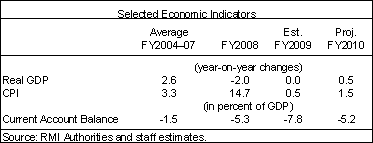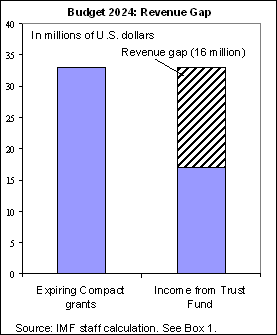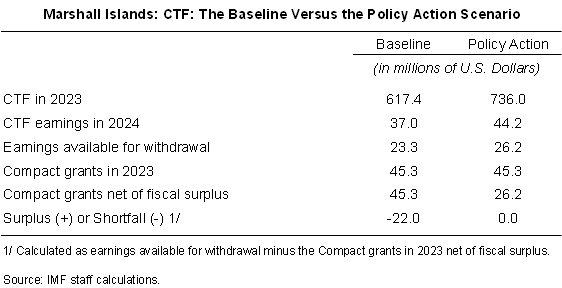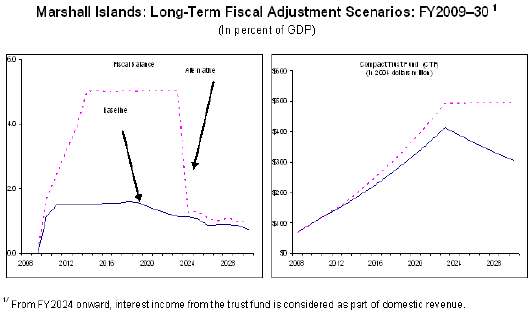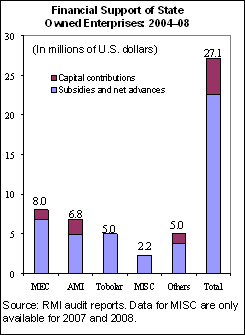Republic of Marshall Islands -- 2009 Article IV Consultation, Concluding Statement of the IMF Mission
November 24, 2009
Describes the preliminary findings of IMF staff at the conclusion of certain missions (official staff visits, in most cases to member countries). Missions are undertaken as part of regular (usually annual) consultations under Article IV of the IMF's Articles of Agreement, in the context of a request to use IMF resources (borrow from the IMF), as part of discussions of staff monitored programs, and as part of other staff reviews of economic developments.
I. Introduction and Background
1. This statement summarizes the mission’s preliminary views and policy recommendations based on meetings in Majuro from November 10–18, 2009. Prior to the consultations, President Jurelang Zedkaia formed a new coalition government. All but one cabinet post remained unchanged, including the Minister of Finance, allowing for uninterrupted government operations and fruitful policy discussions with the mission.
2. This year’s Article IV consultation took place one year after the height of the global financial crisis and the boom in commodity prices. The discussions focused on policies to secure a sustained recovery and long-term economic and fiscal sustainability in 2024, when the amended U.S. Compact agreement expires.
3. The economy is slowly emerging from recession, but medium-term growth prospects are limited. Declining energy and food prices, expansion in the fishing sector, and growing remittances, helped the ongoing recovery. Nonetheless, without new private sector initiatives, the programmed decrements in the Compact grants will suppress growth in the medium term.
4. A comprehensive reform program is needed to secure long-term fiscal sustainability and encourage growth in the private sector. A large revenue gap looms in 2024, when the Compact expires. Closing the gap requires fiscal savings of 5 percent of GDP per year (equivalent to $9 million in 2009 prices) to ensure continuity of government services. This adjustment needs to be coupled with a modernization of the public sector, including through state-owned enterprise reform. Such a program would generate an enabling environment to develop a private sector, which is independent from the Compact.
| Est. | Proj. | ||||||||
| 2006 | 2007 | 2008 | 2009 | 2010 | 2011 | 2012 | 2013 | 2014 | |
|
Real sector |
|||||||||
|
Real GDP (percent change) |
2.4 | 3.3 | -2.0 | 0.0 | 0.5 | 1.5 | 1.5 | 1.5 | 1.5 |
|
Consumer prices (percent change) |
5.3 | 2.6 | 14.7 | 0.5 | 1.5 | 2.0 | 2.5 | 2.5 | 2.5 |
|
Central government finance (in percent of GDP) |
|||||||||
|
Revenue and grants |
74.8 | 71.7 | 70.4 | 67.9 | 66.1 | 64.8 | 63.5 | 60.8 | 60.3 |
|
Total domestic revenue |
25.1 | 25.5 | 25.7 | 23.9 | 24.5 | 24.7 | 25.0 | 25.1 | 25.0 |
|
Grants |
49.6 | 46.1 | 44.7 | 43.9 | 41.6 | 40.1 | 38.5 | 35.7 | 35.3 |
|
Expenditure |
73.4 | 71.4 | 70.6 | 68.1 | 64.9 | 63.3 | 62.0 | 59.3 | 58.8 |
|
Current 2/ |
54.2 | 54.4 | 58.5 | 54.3 | 51.2 | 50.1 | 49.3 | 47.1 | 46.8 |
|
Capital |
19.3 | 17.0 | 12.2 | 13.8 | 13.7 | 13.2 | 12.7 | 12.2 | 12.0 |
|
Overall balance |
1.3 | 0.2 | -0.2 | -0.2 | 1.2 | 1.5 | 1.5 | 1.5 | 1.5 |
|
Compact Trust Fund (in millions of US$; end of period) |
63.1 | 85.5 | 75.7 | 97.3 | 122.3 | 145.0 | 169.6 | 196.4 | 225.5 |
|
Balance of payments (in millions of US$) |
|||||||||
|
Trade balance |
-71.9 | -71.2 | -71.2 | -70.2 | -66.0 | -64.3 | -62.5 | -60.6 | -61.1 |
|
Net services |
-25.7 | -32.9 | -33.5 | -35.4 | -33.2 | -32.8 | -32.1 | -31.4 | -31.9 |
|
Net income |
40.1 | 36.3 | 34.0 | 33.6 | 33.6 | 33.6 | 33.7 | 34.1 | 34.4 |
|
Private and official transfers |
55.2 | 59.5 | 62.7 | 60.1 | 57.5 | 57.5 | 57.6 | 55.5 | 57.0 |
|
Current account including official current transfers 3/ |
-2.3 | -8.3 | -8.0 | -12.0 | -8.2 | -6.0 | -3.3 | -2.5 | -1.7 |
|
(In percent of GDP) |
-1.6 | -5.5 | -5.3 | -7.8 | -5.2 | -3.7 | -2.0 | -1.4 | -0.9 |
|
Current account excluding official transfers 3/ |
-51.3 | -61.3 | -64.7 | -66.2 | -59.8 | -57.5 | -54.7 | -51.7 | -52.1 |
|
(In percent of GDP) |
-35.5 | -40.6 | -42.6 | -43.4 | -38.4 | -35.6 | -32.6 | -29.6 | -28.7 |
|
External debt (in millions of US$; end of period) 4/ |
99.7 | 98.5 | 94.3 | 94.3 | 89.9 | 85.1 | 80.0 | 74.4 | 68.8 |
|
(In percent of GDP) |
69.0 | 65.2 | 62.0 | 61.7 | 57.7 | 52.7 | 47.6 | 42.6 | 37.9 |
|
External debt service (in millions of US$) |
6.9 | 16.2 | 7.8 | 12.2 | 13.1 | 12.4 | 13.0 | 13.0 | 12.9 |
|
(In percent of exports of goods and services) |
32.1 | 65.0 | 27.6 | 46.5 | 46.8 | 41.6 | 40.4 | 37.5 | 34.6 |
|
Sources: Data provided by the RMI authorities; and Fund staff estimates. | |||||||||
|
II. Recent Developments 5. Despite access to large and stable grants under the Compact, the sharp increase of commodity prices took its toll on the economy. Economic output contracted by 2 percent in 2008,1 the first recession in 10 years. Rising energy and food prices—domestic inflation peaked at 28 percent in the third-quarter of 2008—led to a large decline in real incomes and demand. 6. The economy stabilized in 2009 at zero percent growth. Sharply falling domestic prices following the unwinding of the global food and energy price boom arrested the erosion of household incomes. Inflation declined to 0.5 percent in 2009 after reaching 14.7 percent in 2008. The opening of a fish loining factory and reported increases of remittances helped end the recession, but growth contributions were partially offset by job losses due to a reduction in personnel at the U.S. military base in Kwajelein. 7. The fiscal balance remained in deficit in 2009. Mission estimates show a small deficit of $0.2 million (0.1 percent of GDP), roughly unchanged from 2008. A combination of lower tax revenue reflecting the weak economy, tax exemptions granted for imported food and fuel products, and financial assistance to state-owned enterprises were offset by additional grants from donors and higher non-tax income from ship registration fees. 8. Public debt remains high, but assets in the Compact Trust and Social Security Funds are recovering. Government and government guaranteed debt stand at 62 percent of the GDP in 2008, but are mostly on concessional terms (40 percent of the GDP to the Asian Development Bank (ADB)). Grace periods for most of these loans are expiring, raising debt servicing requirements to about $3 million a year (2 percent of GDP). While the drop in global equity markets in 2008 led to significant losses for the Compact Trust Fund (-22.6 percent), the value of assets has recovered since then and stands at $97.3 million at the end of fiscal year 2009. Similarly, the Social Security Fund rebounded to $65.7 million in 2009, but it remains below its peak of $69.0 million in 2007. III. Economic Outlook and Risks 9. The economy will recover gradually in the near term. Growth in 2010 is projected to increase to 0.5 percent. A further expansion in the fish processing industry and additional foreign grant assistance (Taiwan, Province of China and the European Union) provide growth impulses, which soften the negative demand effects of declining Compact grants. Inflation is projected to remain subdued at 1.5 percent. 10. Risks to the economic outlook are tilted to the downside. The economy’s high import dependence means that fluctuations in commodity prices pose a substantial risk to real incomes. Rising prices could stoke inflation and stifle domestic demand. In the current, weak global economic environment, donor assistance may be more difficult to secure, posing another downside risk to growth. On the upside, the planned regional collaboration on managing the fish-stock (Pacific Nauru Agreement) could lead to an additional income source. 11. Over the medium term, the economy will grow more slowly compared to previous years. The scheduled decline in Compact grant assistance will weaken the underlying growth momentum and will only be partially offset by expansions in the fish processing sector and a recovery in tourism. The mission projects that growth will level off at 1.5 percent, well below the average rate of 2.7 percent in 2004–07. IV. Policies to Achieve Sustainable Growth 12. Achieving long-term budgetary self-reliance and sustained growth have become more challenging after the global crisis. In 2024 the government needs to rely on income from the Compact Trust Fund (CTF) to replace expiring annual Compact grants. The projected revenue gap in 2024 has grown since the global crisis and poses a risk to economic and fiscal viability. Under baseline projections, the mission estimates that the revenue gap—the difference between expiring grants and CTF income in 2024—is $16 million in 2009 dollars. (Box 1). 13. Closing the 2024 revenue gap requires a significant, but manageable fiscal adjustment. The mission projects that, in order to accumulate adequate funding in the CTF, the government would have to progressively build up a fiscal surplus of $9 million per year by 2014 (5 percent of GDP). This surplus would need to be maintained until 2023 and the savings placed into the CTF. The cumulative savings would generate a large enough asset base to close the projected revenue gap in 2024. 14. The mission welcomes the government’s intention to target a budget surplus and aim to transfer $2 million to the CTF in 2010, but achieving this goal will be challenging. The elimination of vacant positions and growing revenue from the ship registry will provide important savings, but growing debt repayments and additional assistance to the electricity utility will make it difficult to meet this target. 15. The government recognizes the need for reform and has undertaken important steps to identify necessary policy measures. Two reform commissions, the Comprehensive Adjustment Program (CAP) group, tasked with identifying expenditure reforms, and the Tax and Revenue Reform and Modernization Commission (TRRM) have prepared draft reports for the government. The mission supports these efforts and recommends that the government develop these initiatives into a comprehensive program. 16. The reform program should be based on three objectives: • (i) achieving lasting fiscal surpluses to provide post-Compact fiscal funding through the CTF; • (ii) modernizing the public sector through civil service, tax, and state owned enterprise reform to improve its efficiency and effectiveness; • (iii) and providing an enabling environment for the private sector to develop a growth engine independent from the Compact.
A. Fiscal Adjustment and Public Sector Modernization 17. Both expenditure cuts and revenue gains are necessary to achieve the needed fiscal adjustment. Since revenue measures will take time to prepare and implement (see below), expenditure cuts will have to be taken first. In designing its adjustment program, the government has to weigh cost and efficiency implications, as well as demand effects, given that the government is the single largest employer and private sector is unlikely to absorb any shed labor. The mission estimates that the reforms outlined below could raise savings well in excess of the needed $9 million per year with roughly half coming from expenditure and half from revenue measures. 18. Reducing current expenditure is an important first step toward fiscal sustainability. The public sector wage bill doubled since 2000 and stands now at $34 million (22 percent of GDP) and is significantly higher than in countries of comparable size and income levels.2 • Civil service rationalization. The mission welcomes the government’s plan to conduct a comprehensive public service personnel audit to identify areas of over-staffing and disproportionate pay, where feasible benchmarking civil service wages against those of the private sector. Building on the personnel audit’s findings, a combination of civil service pay cuts and reductions in employment should be phased in beginning next year. An important consideration should be the large public-private sector wage differential, which currently encourages public over private employment. • Limiting financial support to state owned enterprises (SOEs). Although there are several examples of successful public agency reforms (for example, social security administration, MISSA), many public enterprises continue to be a drain on the budget. Cumulative public support through subsidies, net cash advances, and capital injections added up to $27 million between 2004–08, with Marshalls Electrical Company (MEC) and Air Marshall Islands (AMI) being the largest recipients. The mission recommends ceasing untargeted subsidization of energy consumption by raising electricity tariffs to cover production costs and encourage conservation. Exemptions from import duties should be reversed, and remaining subsidies should be targeted and made explicit in the budget (see also paragraphs 26 and 27). • Cutting other expenditures. The government provides allowances (such as housing and electricity) to civil servants and public officials at a significant annual cost to the budget ($1.8 million). The mission supports the CAP’s recommendation to minimize these allowances. 19. The tax system should be modernized to increase revenues and enhance efficiency. The existing tax system lacks the ability to raise additional revenue, fails to encourage private investment, and is inequitable. The gross revenue tax (GRT) taxes exports and has a cascading effect. There is a proliferation of small taxes complicating tax administration, and many sources of income are exempt, generating inequity. • Adopting a comprehensive tax reform program. The TRRM Commission’s proposal should lay the foundation for a modern tax system (Box 2). The mission recommends that the government adopt a PFTAC based proposal guided by two principles: (i) the proposal should be accepted as a uniform package, and (ii) tax rates and thresholds should be chosen to generate additional revenue. Given the amount of preparatory work and time required for implementation (up to 36 months), the mission recommends that new legislation be passed swiftly. • Improving tax administration. Enforcement has been stepped up, but improved capabilities are needed to support the tax reform. Improved audit activities at the social security administration have led to a sizeable reduction in unpaid contributions and improved compliance. Since there are significant gains from harmonizing collection processes and information sharing, the mission supports the establishment of a unified revenue administration as part of the proposed tax reform. 20. Unfunded mandates of the social security system are a sizeable contingent liability. The 2009 actuarial report identifies $180 million of unfunded liabilities (120 percent of GDP). In light of the unsustainable financial situation, the authorities should establish a committee tasked with designing a reform plan. Options could include the increase of contribution rates, an increase of the standard retirement age, or a lengthening of the minimum contributions period, which currently stands at a very low period of 9.5 years. 21. Notwithstanding long-term fiscal challenges, the government needs to build a buffer to deal with external shocks. Large swings in commodity prices and the impact of climate change (e.g. flooding) will likely increase the demand for short-term fiscal support. The mission recommends that the government reserve the RMI’s recent SDR allocation—an unconditional credit line from the IMF of about $6 million (3 percent of GDP)—for precautionary purposes. The terms of its use should be formally regulated. 22. Public expenditure management reforms are overdue. The government made strides in expenditure management since the amended Compact, but cash management is still based on cash rationing. The Minister of Finance should swiftly roll out a commitment control based management system developed with PFTAC assistance and issue a Cabinet endorsed directive for line ministries to develop and report on expenditure plans.
23. Greater performance orientation could improve public service outcomes. The mission commends the government for scaling up performance budgeting (PBB) and encourages the Ministry of Finance to become part of the exercise. Leadership from the Ministry of Finance is critical to the sustainability of PBB after the Compact expires. To facilitate the transition, all resources (Compact and non-Compact) should be included in PBBs and the Ministry of Finance should use the information provided by PBBs to allocate resources and exercise accountability for their efficient and effective use. B. Structural Reforms to Enable Growth 24. A vibrant private sector would contribute to economic and fiscal sustainability. The domestic economy currently depends heavily on income generated from the Compact through the consumption of goods and services, public wages, and construction projects. A self-sustaining business sector independent from the Compact would provide an additional source of income and employment. The unemployment rate currently exceeds 30 percent. 25. The government’s role in supporting private sector growth should be geared towards providing an enabling environment. The mission identifies the following priority areas: (i) reliable and cost efficient infrastructure services with broad coverage, (ii) strengthening education and training of the workforce, (iii) and improving access to secured commercial lending. 26. Many state owned enterprises have government mandated social service obligations which impair their ability to effectively provide services and support growth. The nature and magnitude of community services performed are often not clearly defined, and typically subsumed in the SOE’s overall operating activities through cross-subsidization. This lack of transparency complicates resource planning and has contributed to weak management, underinvestment, and a continued need for subsidies and capital injections. Bottlenecks in electricity provision (MEC) and high costs of telecommunications (NTA), which are magnified by a small market and a high debt burden, have raised the cost of doing business and limited the development of new livelihood opportunities for the outer islands (for example access to electricity, mobile banking). 27. A more transparent delineation between commercial and non-commercial services could improve the performance of SOEs. A possible approach in tackling this problem is the use of contractual arrangements in the form of a community service obligation (CSOs). Such contractual operations between the government and SOEs have been successful in other countries (for example Fiji shipping company). The mission encourages the government to explore such options. 28. In areas where state owned enterprises provide purely commercial services, operation should be divested. The mission welcomes the government’s decision to sell its hotel, the Marshall Islands Resort. We also encourage the government to contract out the management of Tobolar’s commercial activities through a competitive and transparent process, and ensure that procurement processes are abided by. Currently, Air Marshall Islands (AMI) cannot reasonably be expected to deliver on its community service obligations and the government should consider downsizing and divestment. 29. The business environment remains challenging. The 2009 Doing Business report ranks the RMI in 91st place out of 185 countries; below Fiji (39), Tonga (43), Samoa (64), and Kiribati (79). The legal framework for collateral and bankruptcy laws inhibits commercial lending and has kept interest rates high. Since the absence of private land ownership hampers private sector development, the government should step up efforts to facilitate land registration. The mission welcomes the new act on secured transactions for moveable property, which should improve access to commercial credit at reduced costs. C. External Stability and Exchange Rate 30. Risks to external stability are currently limited and the use of the U.S. dollar as currency is appropriate given the size and remoteness of the economy. Compact related financial flows dominate external balances and will continue to provide a stable source of funding over the next decade. In the long run, the expiration of the Compact could lead to an erosion of foreign assets undermining external stability unless needed fiscal adjustments are carried out. 31. There appears to be no evidence of a price competitiveness problem. The 7 percent real appreciation in 2008 was largely reversed in the second half of 2009 as domestic prices fell faster than in the U.S., its main trading partner. More fundamentally, exports as a percentage of GDP have risen over the last decade, while they declined in most other Pacific island economies. D. Financial Sector 32. The banking system remains profitable and well capitalized, but the Banking Commission should remain vigilant and limit consumer borrowing given high household indebtedness. Consumer lending represents 85 percent of total commercial lending. Average household indebtedness on consumer lending is estimated at 50 percent of labor income. There are currently no prudential regulations to limit consumer borrowing. The mission recommends to modify the Banking Act to introduce limits to consumer borrowing. It also encourages the banking commissioner to continue strengthening monitoring capabilities. Interest rates should be market determined. Moreover, data on remittances should be captured and regular reports issued. 33. The mission urges the authorities to place the development bank under the Banking Commission’s jurisdiction and cease its unsecured consumer lending. The development bank is heavily engaged in unsecured consumer lending and these activities are not monitored or regulated by the Banking Commission. These pose a significant risk to its capital base and to the government as its sole owner and should be ceased. E. Other Issues 34. There is a need to improve the reliability, coverage, and timeliness of economic statistics to guide policy. The mission commends ongoing efforts by the Economic Policy, Planning and Statistics Office (EPPSO) to improve data collection and recommends continued financial support for staff training and education programs. The mission also supports efforts to carry out a new national census, which is critical in assessing demographic and socio-economic developments and guiding policy making. 35. While financial and compliance audits are adequate, most audit functions are currently outsourced. The country could benefit from improving the capacity of the Office of General Auditor to carry out financial compliance, and eventually performance-based audits. Capacity-building Compact grants could be utilized to build local capacity in the auditing and accounting areas. The mission would like to thank the authorities for their hospitality and thank members of the government, private sector, and civil society for the fruitful discussions. |
|
Table 1. Marshall Islands: medium term Scenario, FY2006–14 1/
1 Annual data refer to the fiscal year ending in the third quarter. 2 Craig Sugden and Kiyoshi Taniguchi 2008: The Growth Penalty of High Government Pay Rates, ADB Economics Department Working Paper. 3 After 2024, the government still runs overall surplus to service external debt. | ||||||||||||||||||||||||||||||||||||||||||||||||||||||||||||||||||||||||||||||||||||||||||||||||||||||||||||||||||||||||||||||||||||||||||||||||||||||||||||||||||||||||||||||||||||||||||||||||||||||||||||||||||||||||||||||||||||||||||||||||||||||||||||||||||||||||||||||||||||||||||||||||||||||||||||||||||||||||||||||||||||||||||
IMF EXTERNAL RELATIONS DEPARTMENT
| Public Affairs | Media Relations | |||
|---|---|---|---|---|
| E-mail: | publicaffairs@imf.org | E-mail: | media@imf.org | |
| Fax: | 202-623-6220 | Phone: | 202-623-7100 | |








